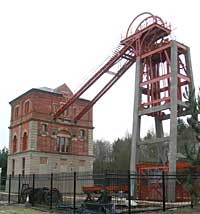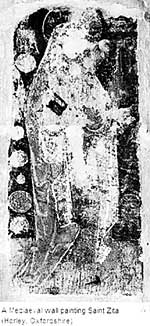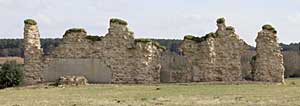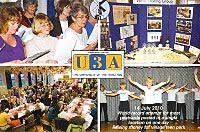News for Summer 2010
Bestwood Winding Engine

At the present time no information is available on the Nottinghamshire County Council web site about the opening to the public of the restored Winding Engine and Dynamo House at Bestwood Country Park. The County Council's Heritage and Conservation News Winter 2009/10 issue suggested a grand re- opening would happen in Spring 2010. This information is repeated on the County's web site.
1990-2010: 20 YEARS OF ARCHAEOLOGY FOR EVERYONE
The Festival of British Archaeology 2010 will be held from Saturday, 17 July to Sunday, 1 August, the annual 'extravaganza of heritage events'. Each year the Festival showcases the very best of British archaeology by presenting hundreds of special events organised and held by museums, local societies, national and countryside parks, universities and heritage organisations across the UK. The Festival presents everyone with an opportunity to learn about their local heritage, to see archaeology in action, and to get involved.
Events ranging from excavation open days and behind-the-scene tours to family fun days, hands-on activities, guided walks, talks and finds identification workshops take place all over the UK during this special fortnight. The Festival is being coordinated by the Council for British Archaeology and details of events will be available on their website soon at www.britarch.ac.uk.
Barbara Cast
COUNTY SOCIETIES SYMPOSIUM
A one-day symposium was held on 1st May under the auspices of the Victoria County History and its Director, our own Chairman, Professor John Beckett, which provided a forum for county societies, archaeological, historical, antiquarian, natural history and records, to meet together to discuss matters of mutual interest and to share best practice. Partners in the symposium included the Institute of Historical Research, the British Association for Local History, the Historical Association and the Royal Historical Society. The meeting was held in Senate House, the home of the Institute for Historical Research, University of London. County societies were invited to send representatives and about forty people attended, representing a good proportion of the county societies. Thoroton was represented by Barbara Cast, with members David Crook and Sue Clayton giving presentations, and of course John Beckett in the Chair.
The aims of day were to explore the current challenges to societies, to consider change and how to best address the future of our societies, individually and as a body of organisations which might share information and good practice on a more formal and ongoing basis.
Professor Beckett opened the meeting by welcoming us to the symposium and gave an outline of the growth of local history since the nineteenth century and the emergence of county societies, which by the end of the Victorian era covered all but about two counties. The emergence of the VCH was very much tied in with the county history societies which provided much of the scholarly work for the early volumes. Many county societies still exist, with local history and family history societies adding to the number of people involved in history related activities. However, Professor Beckett set out some of the problems currently facing the sector, including the demise of the Adult Education movement due mainly to government policies. This was one of the subjects to be addressed at this event.
The second speaker was Gill Draper of the British Association for Local History who spoke of the role of the organisation and gave some helpful suggestions for the county societies.
Next was a session on future trends in local history publishing with Dr John Chandler, an independent local history publisher from Hobnob Books based in Wiltshire, and Peter Clifford and Mike Webb of Boydell & Brewer, a specialist publisher of history and archaeology books. The rise in print on demand and e-publishing were amongst the topics discussed.
After lunch the discussions centred on Record Societies and their work, led by Dr David Crook and Dr Peter Durrant of the Berkshire Record Society. The relevance of national archives to local societies was noted and ways to meet the challenges of publishing were explored.
Following this the subject of digitisation and the County Societies was discussed by Andrew Foster of the Historical Association and Jonathan Blaney of British History on Line. Most of the county societies represented had active websites and the potential for maximising access to their documentation was an interesting subject for discussion.
The last of the sessions concentrated on County Societies and the future of Adult Education provision and was led by Sue Clayton, who is currently researching and drawing up a paper for Thoroton and NLHA on local provision, and Don Henson of the Council for British Archaeology, which is also considering how to fill the gap in education left by universities. It was evident from the presentations that there is no drop in demand for history and archaeology based learning, fuelled in part by the explosion in community heritage projects. The challenge and opportunity is for the county societies to consider the contribution they might make in hosting courses and, in particular, how younger people might be more involved in our subjects.
The day ended with groups of delegates debating issues raised during the symposium and considering whether they felt that an ongoing forum for the county societies would be useful - the overwhelming view was that it would be, both as a virtual forum for sharing best practice, events, publication lists etc. and as an annual event. So more to come - thanks to John and his team for arranging a most interesting and useful day.
Barbara Cast
Nineteenth century British newspapers

Newspapers have traditionally been a difficult resource for local and family historians to use because of the lack of suitable indexes. Now the Gale Group have placed online some fifty titles held by the British Library, including Welsh, Scottish and Irish newspapers. Of particular interest are the Derby Mercury and the Nottinghamshire Guardian, the latter previously only held by the Local Studies Library on Angel Row, Nottingham, in hard copy, and not usually produced for the public to use.
The Derby Mercury was a weekly newspaper, which commenced publication in 1732. It was widely circulated outside Derby and advocated the interests of agriculture, commerce, manufacturing and the Church of England. It ceased publication in 1933.
Full-text coverage is now online for the period January 1800 to December 1900.
The first issue of the Nottinghamshire Guardian
appeared in May 1846. It allied itself with the defence
of agricultural, commercial and colonial interests, and as such was very much Conservative in its orientation. By 1851 circulation of the paper had reached 112,000 copies. The newspaper was long associated with the Forman family who owned it from 1852 onwards. It ceased publication in December 1969. Full-text coverage of the Nottinghamshire Guardian is now online for the period January 1849 to December 1900.
All the British Library newspapers which have been placed online by the Gale Group can be searched by keyword, date and title, from any Nottingham City or Nottinghamshire County library computer, and relevant articles downloaded free of charge. The site can be accessed free of charge from your home computer via the library service's website, but a current library membership card is required for this facility.
Philip Jones
BEAR JUGS AND ALE MUGS


Bear jug and posset cup.
A new exhibition at Nottingham Castle Museum showcases the outstanding brown salt-glazed stone pottery produced in Nottingham during the 18th century. Stoneware was more robust than earthenware and was developed in Germany, but, by c1690, Nottingham was one of the earliest places in England to adopt the new process. A local brickmaker - James Morley - achieved within fifteen years or so a quality of potting which could rival that of both England and the Continent at the time. His family continued production until the 1790s. Nottingham's stoneware is famous for its lustrous metallic sheen and also for bearing more personal inscriptions and dates than any other type of English pottery. An example is the two handled posset pot dated 1700 and named for the town's Mayor and Mayoress, Samuel and Sarah Watkinson. (see illustration on the back page). The ware is also known for novelty products such as jugs in the shape of bears with mock fur (back page), and puzzle jugs challenging the drinker to consume the contents without spilling them. The pottery was made at three main sites - now buried under the Ice Stadium, the Victoria Centre and a car park near to Brook Street - and was distributed all over the country and exported abroad; fragments have even been excavated from the site of George Washington's plantation home in Virginia, U.S.A.
This new exhibition contains nearly 200 exhibits, mainly from the Castle Museum collection but including examples borrowed from other museums and from private collections never before exhibited. Many have been newly conserved and cleaned and are illuminated to display their lustrous finish to the best advantage.
An accompanying fully illustrated colour catalogue contains two essays on recent research into the subject - one on the technical and artistic development by Robin Hildyard, retired Senior Curator of ceramics at London's V&A Museum (and a relation of Myles Hildyard, the late President of the Thoroton Society and the other on the history of the local potters and their potteries by the former County Archivist and Editor of Transactions, Adrian Henstock.
The exhibition can be seen on the Mezzanine Gallery of the Castle Museum until 7 November 2010. The catalogue costs £15 plus £3.50 p&p - contact tom.price@nottingham.gov.uk or telephone 0115- 915-3592.
An accompanying series of daytime public events includes: Pamela Wood talking on the range of wares (22 June), Adrian Henstock talking on the local potteries (14 July), a Gallery tour (22 July) and a talk and demonstration by potter John Hudson (25 September). Booking is essential on 0115-915-3700.
SAINTS, SINNERS AND STORY TELLERS MEDIEVAL WOLLATON MANUSCRIPTS AT THE UNIVERSITY OF NOTTINGHAM

Over the last few years, three related projects in the Manuscripts and Special Collections department at the University of Nottingham's King's Meadow Campus, have concerned a group of medieval manuscripts closely related to the Wollaton area. Ten items in the Wollaton Library Collection, from a family library formerly at Wollaton Hall, are in question, together with the magnificent Wollaton Antiphonal from St. Leonard's Church, Wollaton. A grant from the Heritage Lottery Fund has supported much of the work, involving conservation, digitisation, the development of web resources and - as advertised here - a local exhibition.
The collection offers an extraordinarily rich perspective on the literary tastes and religious faith of our medieval ancestors. Illustrated French romances and fourteenth-century texts in English demonstrate the move of literature from Latin to native languages, while a single leaf records in English the life of St. Zita, the Italian saint of housekeepers. These works have faced many risks to their survival over the centuries; binding features are often lost over time, some even through later repairs. While the Wollaton volumes all remain fragile, they provide valuable evidence about their first creation and use; a particular feature of the display will be the use of digital images to show details of production and decorative design.
A series of lunchtime talks will give more information about the wider medieval context of the literature featured and add details about particular aspects of the display, such as the alabaster of St. Zita on loan from Nottingham Castle Museum.
The exhibition is at the Western Gallery, D.H. Lawrence Pavilion, Lakeside Arts Centre, University Park, University of Nottingham until Sunday, 1 August 2010. Free admission.
Further details in the Lakeside's On booklet or from Manuscripts and Special Collections, 0115-951-4565, email: mss.library@nottingham.ac.uk
Ed: St. Zita appears to have been a simple lady and is described as follows in the Oxford Dictionary of Saints:- Sitha, (Citha) (1218-72), a serving-maid of Lucca. Born at Monsagrati, she served the Fatinelli household from the age of twelve for the rest of her life. Often misunderstood and criticized by them, she eventually won their respect through her persevering devotion. Many miracle stories were told of her, including the attribution to angels of the baking of her loaves while she was rapt in ecstasy. Soon after her death a popular cult grew up round her tomb in the church of the Canons Regular of St. Frigidanus, shared in some degree by more prominent members of society. A liturgical cult was permitted in that church only by Leo X in the early 16th century, but it was solemnly confirmed as 'immemorial' in 1696; Her name was added to the Roman Martyrology in 1748 by Benedict XIV.
Her popular cult had already spread to other countries in the later Middle Ages. Testified by chapels in her honour as far afield as Palermo and Ely. In England she was known as Sitha and was invoked by housewives and domestic servants, especially when they lost their keys or were in danger from rivers or crossing bridges. She occurs in mural paintings (Shorehampton, Oxon), in stained glass (Mells and Langport, Somerset), and on rood screens in Norfolk (Barton Turf), Suffolk (Somerleyton), and Devon (Ashton). But her cult seems to have been popular and unofficial. No churches were dedicated to her, although St. Benet Shorehog (London), which had a chapel of St. Zita, was commonly known as St. Sithes. She appears in some English calendars, especially from Lincolnshire. Feast 27 April.
SIR FRANCIS BURDETT, 1770 - 1844 By Terry Fry
Almost exactly 200 years ago Sir Francis Burdett caused consternation in the House of Commons and uproar in the country when he was committed to the Tower of London after annoying the Government yet again with his outspoken criticism. The Mayor of Nottingham and thousands of its citizens protested vociferously about the heavy-handed treatment of this champion of individual liberties.
Sir Francis was born on 25 January 1770 at Foremark, Derbyshire where he inherited the estate. He quickly made his mark as an anti-establishment figure when he was expelled from Westminster School in 1786 after a rebellion. He was quick- tempered and melancholic but, in 1798, he said he had 'a strong feeling of indignation at injustice and oppression and a lively sympathy with the sufferings of my fellows'.
He was adamant about the need for reform of the House of Commons which he expected would regenerate Society, an idea adopted by the Chartists. Frequently he voted against fiscal and tax bills, hoping to save both landowners and labourers from excessive taxation. He also opposed repeated suspension of habeas corpus. His speeches were widely reported in the press and he was caricatured in hundreds of political cartoons and was known as the 'Man of the People'. Ironically, considering recent events, he criticised corruption in Parliament.
After his criticism of the narrow franchise and complaints about the Napoleonic War he was found guilty of breach of privilege by the House of Commons due to his language in a letter to Westminster electors, published in William Cobbett's Political Register. On 16 April 1810 he was committed to the Tower but barricaded himself in his London house. There were clashes between troops and the mob before he was removed to serve his time until the end of the Parliamentary session on 21 June.
The Nottingham Review, the town's radical newspaper, took a keen interest in the affair from 6 April onwards. It was front page news every week until 6 July. On 20 April, subscribers were amused to read the letter from Sir Francis Burdett in which he stated that he would file a Bill against the Speaker of the House for trespass and false imprisonment. On 18 May Sir Francis also served notice of prosecution on the Earl of Moira, Constable of the Tower. The Review kept the pot boiling with regular references, even a poem on 1 June to be recited to the tune of 'Hearts of Oak' ending That he's always a Champion in Liberty's Cause'.
By contrast the Nottingham Journal, a Tory newspaper, was slow to take up the story; not until 26 May was there a reference. Then Wright Coldham, the Mayor, called a Public Meeting to protest about Sir Francis' committal. It was convened at the Guildhall for 30 May but had to be moved to the Market Square because an estimated 5,000 people turned up. The Mayor regretted that 'the House of Commons had assumed the Offices of Prosecutor, Judge, Jury and Executioner in its treatment of Sir Francis Burdett who was 'dragged from his house, his Castle, by an Army', etc.. This was 'a determined wish to subvert the Liberties and Rights of Britons'. They pledged to send a Petition to the House of Commons praying for Parliamentary Reform, and an Address to Sir Francis in 'Gratitude for his patriotic conduct in defence of our Liberties'. The letter was signed by 3,800 supporters in Nottingham.
When he was released on 22 June there was great rejoicing across the country; his popularity was never higher. The Nottingham Review printed a separate sheet about his release. Monday 25 June was chosen for 'much outward display of rejoicing amongst the local Democrats', as the Nottingham Date Book put it. The Review recorded 'the display of Purple and Orange flags, dinners, bonfires and dancing, and ten sheep roasted'. Transparencies of Sir Francis were shown at the Turk's Head and Mason's Arms and The Volunteer Band of New Radford and Lenton took a stage coach around the villages nearby. A few days later the newspaper placed an advertisement on its front page for portraits of Sir Francis Burdett at one guinea each.
That wasn't the end of Sir Francis' radical outbursts. After the Peterloo Massacre in 1820 he was found guilty of seditious libel and sentenced to Marshalsea Prison for three months and fined £2,000.
He died on 23 January 1844. 'Burdett and Liberty' and 'Burdett and Independence' were frequently heard in the early 19th century. A genteel democrat in an age of oligarchy, he was both revered and despised. Disraeli lampooned him as Sir Franceys Scrope in 'Endymion', and Thomas Moore said he was 'neither very sensible nor deeply informed'. But at least up to 1820 he was the main figure of the radical reform movement and, as such, revered by many in Nottingham and the county.
NEWS FROM THE ARCHIVES
Nottinghamshire Archives report the recent acquisition of two collections of nationally important business records.
CLASP
The Consortium of Local Authorities Special Programme (CLASP) was established in 1957 to answer the need of Local Authorities for a mass- produced system of producing public buildings at a reasonable cost. The need initially arose from a post-war requirement for more school buildings resulting from the raising of the school leaving age from 14 to 15 years in 1947. In the mid 1950s Nottinghamshire County Council developed a component system of steel pin-jointed frames designed to combat the subsistence problems of the county. Other Local Authorities became interested and the Consortium was established with a view to lowering the cost of the system by volume ordering. About 400 boxes of archive material have been donated to the Nottinghamshire Archives by Scrape System Build Ltd. The material comprises of minutes, reports, correspondence, project files, technical drawings and photographs.
T. CECIL HOWITT
About 80 boxes of material comprising agreements, specifications, plans and many photographs have been bought with the assistance of grants from the MLA/V&A Purchase Grant Fund and the Friends of the National Libraries. Thomas Cecil Howitt (1889-1968) was a leading architect who designed the Nottingham Council House and Exchange Building which opened in 1929. He was born in Hucknall, educated at Nottingham High School, became a RIBA Associate in 1911 and, after service in WW1, was employed by Nottingham City Council. He entered private practice in 1931 and subsequently designed buildings throughout England and Wales. In Nottingham his buildings include the Portland Building at the University of Nottingham, the Newton Building of Trent University, Raleigh Head Office, Home Brewery Offices and many other smaller buildings. ACCESS Until these two collections have been catalogued access is by prior arrangement with the Nottingham Archives (0115-950-4524); email: archives@nottscc.gov.uk
The dovecote at Thoroton
This fascinating building is owned by the Nottinghamshire Building Preservation Trust Ltd. The Trust's Newsletter of March 2010 reports that their Technical Expert has been working on plans for restoration work on the dovecote for some time. These involve restoring the thatch, replacing the lost glover and providing some limited access for the public. It is hoped that the necessary work can be started as soon as planning consent has been approved.
KING JOHN'S PALACE, KING'S CLIPSTONE

King John's Palace, King's Clipstone after restoration.
Philip Jones has sent a clipping from the Mansfield Chad relating to work being done at King John's Palace. A repair scheme costing £106,500 has been funded by English Heritage and the Nottinghamshire County Council. Tests had revealed that the structure was in imminent danger of collapse caused by centuries of erosion. The work undertaken by specialist craftsmen has securely mortared and tied together falling masonry and the wall heads have been protected with turf.
The ruins consist of the historically important remains of a Romanesque hall dating to Henry 11 and what is present today is only a small part of a much larger complex of buildings. Tim Allen of English Heritage is quoted as saying 'Thanks to the skills of specialist craftsmen, the ruins of this important medieval hunting lodge can be preserved and enjoyed for years to come'. The County Council's cabinet member for Environment and Sustainability said that it 'is an honour to be able to further strengthen Nottinghamshire's history for future generations to enjoy'.
A RECORD ATTEMPT

A record attempt is being made in Keyworth to break the world record for the number of picture postcards posted in one location on one day. Over 20 local businesses and organisations have sponsored 1,000 postcards each and the illustration below is the card of Keyworth and District U3A and which is typical of the style of the cards. The cards cost 65p each which includes a second class stamp and the profits from the cards is going towards the provision of a 'Teen-park' in the village which is a much needed facility. The cards will be postmarked with a special cancellation stamp which will only be used for this one event. The cards have to be posted at Keyworth Post Office on the day, Wednesday 14 July 2010, or in a special post box inside the Post Office before that actual date. Cards are available from Keyworth Post Office and the village supermarkets or by contacting Reflections of a Bygone Age on 0115-937-4079. There are postcard collectors in the Thoroton Society and those who collect cards relating to the County will not wish to miss this opportunity of obtaining such a special issue. Others may well wish to help the project by buying a card or two. The attempt will bring publicity to the County and arrangements have been made for media coverage on the day of the event.
LOWDHAM BOOK FESTIVAL 2010
The Society is to have a stand at the Lowdham Book Festival this year on Saturday 26 June. We shall have our display boards with an attractive display about the Society and, of course, our publications will be on sale. It is also hoped to attract some new members to the Society and to raise awareness of our existence and work.
Helpers are required on the day and anyone who is able to lend a hand, even for a short time, should please contact our Hon. Secretary, Barbara Cast on bandpcast@btinternet.com.